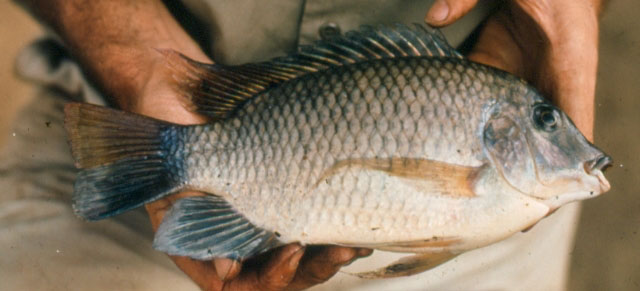| Cichlidae (Cichlids), subfamily: Pseudocrenilabrinae |
| 27 cm TL (male/unsexed) |
|
benthopelagic; freshwater |
| Africa: Cavally and Nipoué (= Cess) Rivers in Côte d'Ivoire and Liberia; also reported from the upper St. John River in Liberia (Ref. 7378, 53405). |
|
Dorsal spines (total): 15-16; Dorsal soft rays (total): 12-13; Anal spines: 3-3; Anal soft rays: 9-10. Diagnosis: lower pharyngeal bone about as long as broad, with anterior lamella shorter than toothed area; median pharyngeal teeth not broadened; upper part of caudal fin yellow-orange, lower part greyish; dorsal fin with 15-16 spines and 12-14 soft rays; 9-13 lower gill-rakers (Ref. 53405).
Description: deep-bodied; head short; frontal profile steep (Ref. 52307). Outer jaw teeth bicuspid and non-spatulate, posterior pharyngeal teeth tricuspid (Ref. 53405).
Coloration: in life: juveniles: ground colour greyish with 5-6 dark cross bars and sometimes dark horizontal band; soft part of dorsal and upper part of caudal fins uniformly grey; well marked "tilapian" spot, disappearing in adults (Ref. 53405). Adults: uniformly grey, but distal area of soft part of dorsal and upper part of caudal fins orange-red; spinous dorsal fin blackish distally (Ref. 53405). Lower part of caudal fin gray to grayish-blue; anterior body parts occasionally a bit reddish (Ref. 52307). |
| Mainly herbivorous, but also takes small amounts of insects; pair-bonding, biparental, open substrate spawner that builds large, deep pits on the river bottom (Ref. 52307). |
|
Endangered (EN); Date assessed: 19 August 2019 (B2ab(i,ii,iii)) Ref. (130435)
|
| harmless |
Source and more info: www.fishbase.org. For personal, classroom, and other internal use only. Not for publication.

